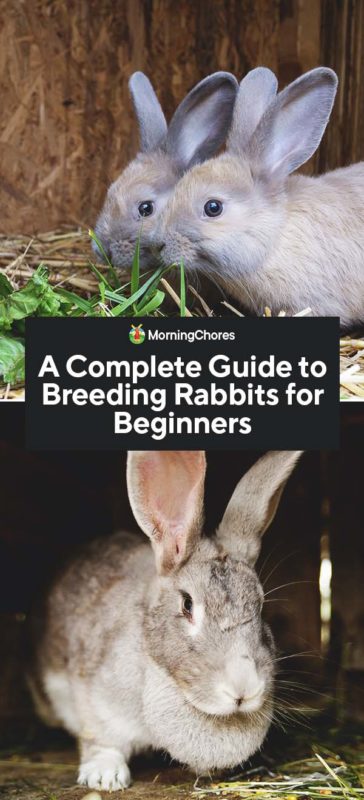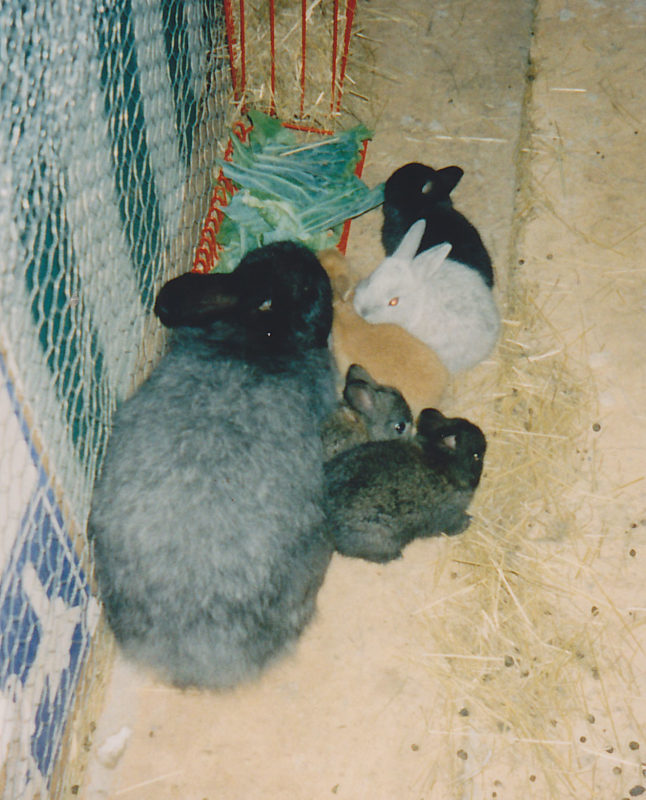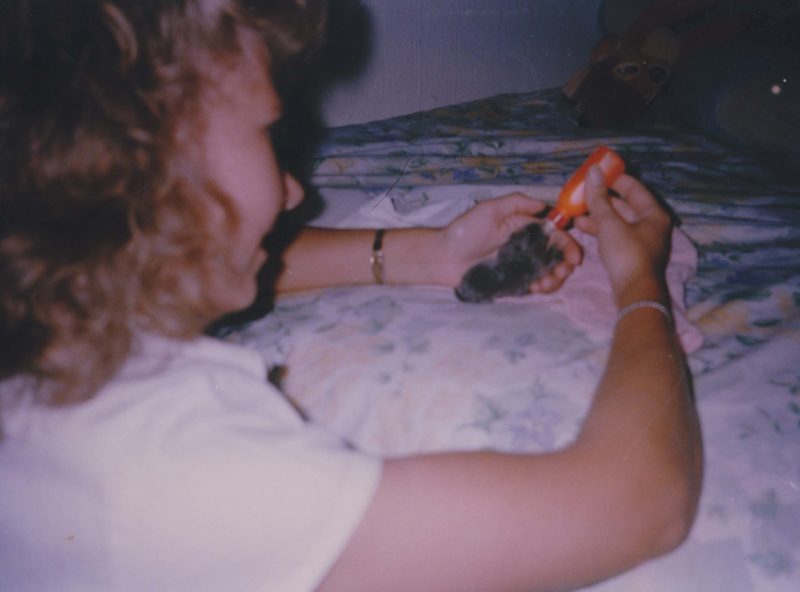How Many Babies Do Rabbits Have in Their First Litter
If you buy an item via links on this page, we may earn a commission. Our editorial content is not influenced by commissions. Read the full disclosure.
You've undoubtedly heard the phrase, "They breed like rabbits!" and it's a phrase that reflects the prolific ability for rabbits to reproduce frequently, and easily.
If you are planning on starting a small rabbitry, breeding rabbits will be at the forefront of your operation. So, knowing how to produce a healthy litter from a healthy doe, is essential to your operation.

Choosing a Breed Depending on Your Purpose
The breeds you choose to keep, and breed, will depend on what you would like to use your rabbits for. Here's a list of some of the best breeds for each of the following uses:
- Meat: Californian, New Zealand, Silver Foxes
- Fiber: Angora
- Pet: Flemish Giants, Rexes, Polish, Dutch
Each of these breeds will reproduce well, but the meat breeds are the large litter breeds desired by most rabbitries. They produce the most quantity of kits and the most meat per adult rabbit.
When to Breed Rabbits
Rabbits should not be bred until they are at least 6 months of age due to complications that may arise.
Unlike many other mammals, rabbits can be bred year-round. Their reproductive cycle is extremely unique! They do not ovulate unless they have been bred…in fact, the act of breeding induces ovulation.
With that being said, there are times when does are more receptive to being bred.
Selecting Your Breeding Pairs

It's important to select pairs that are the same size. Breeding a large buck to a small doe may result in a difficult pregnancy. Kits may be too large for the doe to carry.
A good rule of thumb is to mate rabbits of the same breed to each other rather than cross-breeding large and small breeds.
And never breed kits from the same kindling with each other. However, a doe can be bred back to the buck who produced her, and the same goes for bucks and the does. This is called in-line breeding.
Most in-line breeding is done to amplify the desirable traits of the 2 rabbits chosen to breed. Always keep in mind, however, that inbreeding can also magnify undesirable traits, so choose carefully.
How to Prepare The Buck's Hutch for Breeding
When it is time to breed your rabbits it is best to do so on solid ground. Cages with wire bottoms can catch rabbit toenails or even feet, and cause serious injury if the rabbits are rambunctious.
If you only have wire-bottomed cages, place a temporary wooden floor in the bottom of the buck's cage for breeding and remove it after. Also, remove any feeders or waterers that the rabbits could get tangled up in, and to give them more room.
Lastly, always take the doe to the buck's cage because does are extremely territorial and may act out aggressively toward your buck.
The Rabbit Breeding Process

Now that you know how to select and prep your rabbits for breeding, it's time to get down to the birds and the bees of the process!
1. Sexing Rabbits
Sexing rabbits is not an easy task, but it can be learned with some practice. It's challenging to differentiate males from females and to make matters worse, it's even harder to hold your rabbits while sexing them. This makes the process even more tedious.
Young rabbits are more difficult to sex than mature rabbits. While you can attempt to sex them at a young age, it's best to wait until they are full-grown. At least until you know what you are doing.
Here's how to do it:
- Hold your rabbit gently by the scruff of its neck and lift it up, supporting its weight with your other hand or arm.
- Lay the rabbit upside down while supporting its back (cradle your rabbit in your arms).
- Your rabbit will relax if held securely.
- Using your middle finger and forefinger apply pressure to the vent to force the genitals to protrude just slightly.
- Observe the protuberance: Does have a narrow slit, lined with pink, while bucks have a tube.
2. Mating Your Rabbits
Once you have placed the doe in the buck's cage, the breeding process will begin. The two rabbits may chase each other, smell each other, and the buck may stomp his feet. There will be grunting, squealing, and other lovely rabbit sounds that you never thought existed.
The buck will mount the doe and bite her on the back of the neck for stability, and to keep the doe in place. Don't worry, he isn't hurting her.
If the doe is receptive, she will lay on her stomach and present her backend to the buck. On the other hand, she may sit up and hide her bottom from the male if she does not want to be bred.
If the doe acts aggressively toward the buck, or vice versa, carefully remove the doe as soon as possible. Never force rabbits to stay in a cage together, or leave them unattended. If you do, you may have a fatality on your hands.
You can tell if your buck has bred your doe if he falls off of her…yes, it's actually pretty dramatic. He will often squeal or grunt and just roll to the side of her. He's ok, so don't worry!
For good measure, we often let our buck breed our does at least 3 times in a breeding session. However, usually, he is pretty pooped after the second time. Good bucks will get the job done fast.
Once they've successfully bred, remove the doe from the cage and return her to her own. Then, replace the feed and water dishes for the buck. He will be thirsty!
Make a note in your homesteading journal of the date bred, and use our gestation calculator to know when you can expect the kits.
3. Is The Doe Pregnant?
There are signs to watch for that will indicate your doe is pregnant, but without an ultrasound, none of them are reliable.
Here are a few indications your doe may be pregnant:
- You can feel babies when you gently palpate her abdomen
- She has gained weight (weigh her before she is bred and 2 weeks after)
- She starts nesting about a week before kindling
If you want to be sure, and safe, take your doe to your veterinarian for a solid answer.
4. Doe's Nesting Material Box
Does are adorable when they start nesting, they hop about, building their nest just so. Still, if does don't have the proper "equipment" they may not be able to care for their kits appropriately. It's up to you to ensure that they have a warm, draft-free, nesting box available at least a week before they kindle.
The nesting box shouldn't smell like other animals or rabbits. If you've used a nesting box for any other purpose be sure to clean it long before offering it to your doe. Ensure that the doe has ample time to get used to the nesting box in her cage.
Straw or this soft nesting material should be provided for the doe to create her own nest. She will do this on her own so don't worry about making the nest for her.
A few days before she gives birth, the doe will start gathering the best pieces of straw for her nest. Then, she will go to work building a safe-haven for her babies.
5. Gestation Period and Kindling
From the time a doe is bred to kindling about 30 days will pass…give or take a little. During the gestation period, the doe should not be handled often, and her nesting box should be left untouched.
Your doe will need a little more food than usual, but don't overdo it. Overfeeding pregnant does can cause miscarriages and often the birth of 1 or 2 fat babies. So, gradually increase her food intake, provide plenty of roughage and water.
About a week before your doe gives birth, she will begin to pull fur from her body to add insulation to her nest. This is a great way to tell she is pregnant because some does start pulling 2 weeks before they kindle.
With that being said, don't be discouraged if your doe is not nesting. Some does go to work shortly before they kindle.
As a side note, pulling fur can also be a false alarm. Some does have false pregnancies and build beautiful nests without giving birth. These misleading behaviors may be due to a miscarriage or the mimicking of other pregnant does nearby.
How to Care for The Doe During and After Pregnancy
When your doe goes into labor, you probably will not be nearby. It's amazing how often they kindle in the evenings, or when no one is around to be nosey. It is best to leave your doe alone anyway, as this is a very important time for her. If she becomes stressed, she may miscarry or eat her babies.
I know, it's a horrible thought, and even worse to witness, but remember, your rabbit is an animal and doesn't always realize what or why she is doing something.
Try your best to let nature take its course.
After the kits arrive, make sure the doe has plenty of water and monitor from afar. She will clean herself up, and begin nursing her kits on her own if all is well.
Don't worry if she's not in the nesting box with her kits all the time. She will give herself breaks, and need to catch her breath after giving birth.
Taking Care of the Kits

Mom will do all the heavy lifting, so in the spirit of letting nature take its course, allow the doe to care for her kits on her own. She will feed them when needed, cover them up with warm fur, and wean them when the time is right.
The only things you need to worry about are keeping the cage clean, and the feeders full.
Babies are born without fur, but you can usually see what colors they will be by observing the color of their skin.
Kits start opening their eyes within about 10 days of their birth. It is normal to see them hopping out of their nest after about 2 weeks.
Unfortunate Complications
As with all things, there will be times when kindlings go south. It isn't easy to see or handle when your doe doesn't produce a litter as expected or behave as expected.
Does who have never been bred before should be given a pass if they fail at being a mom the first time around. Perhaps they were too young or just weren't ready. We don't know why it happens but sometimes young does don't care for their babies, or worse, they eat them.
Check out this list of common complications, and how you can handle each one:
1. Eating Babies
It's a horrific sight, and I want you to be prepared for it because if you plan on breeding rabbits longterm, you will witness at least one of your does consume her young. Cannibalism occurs for many reasons, but more often than naught, it's a lack of experience or lack of motherhood characteristics.
Don't worry about the doe, though, she will be ok if she has eaten her young. However, if live kits remain, consider giving them to a nursing doe.
Using a foster doe can be risky, so be sure to weigh your options. For example, the doe may kill the babies, including her own. Foreign smells or sick kits are not going to be welcome in all does' nests.
2. Babies Born Outside of Nesting Box
First-time mothers are usually the culprits when kits are strewn around the cage rather than their warm nest. It's possible the doe just didn't know where to put them, or what to do with them.
We've had does with beautiful nests give birth on the cold caged floor. So, who knows what screw got loose on that one!
If the babies are still alive, you may pick them up and place them back in the nesting box. If they are cold, you should try to warm them up in your hands or with a heat lamp.
Sometimes the babies may barely be alive due to the cold, but warmth breathes life back into them quickly. As soon as they are warm, return them to the nest. If you are lucky, mom may figure things out from there.
3. Too Many Babies
Sometimes a doe may have a litter that is just too much for her to handle. Often the runts end up on the bottom of the pile, never able to reach the teet of their mother. They usually end up starving to death.
If your doe has had a very large litter, consider a foster doe that is also nursing. Often, a doe with fewer kits will be accepting of more babes. Always consider the risks before deciding to offer a kit to a foster mom (see above).
4. Miscarriage and Infections
Like most mammals, there are always risks for complications before, during, and after giving birth. Watch for lethargy, loss of appetite, and water intake to monitor signs of potential illness.
If you suspect that your doe is ill, consider taking her to the vet for evaluation, and make sure to keep her far from healthy rabbits.
Miscarriages happen for countless reasons including poor nutrition, weather, illness, stress, and more. Remove fetuses from the doe's cage as soon as possible to prevent bacteria and the spread of infection.
The Joys Of Breeding Rabbits

Breeding rabbits is a rewarding experience, but it's not without its heartaches here and there. If you are prepared for some of the more common complications, you can keep a level head while you care for your rabbits and their new kits.
If you as a homesteader are considering keeping and breeding rabbits, they can produce a steady additional income. We discuss this in detail with our post on Raising Rabbits for Profit. Be sure to first construct hygienic and safe rabbit hutches, and be well informed on rabbit care, before ordering your first furry rabbits, and experiencing the joys of keeping rabbits.
Was this article helpful?
Yes No
How Many Babies Do Rabbits Have in Their First Litter
Source: https://morningchores.com/breeding-rabbits/